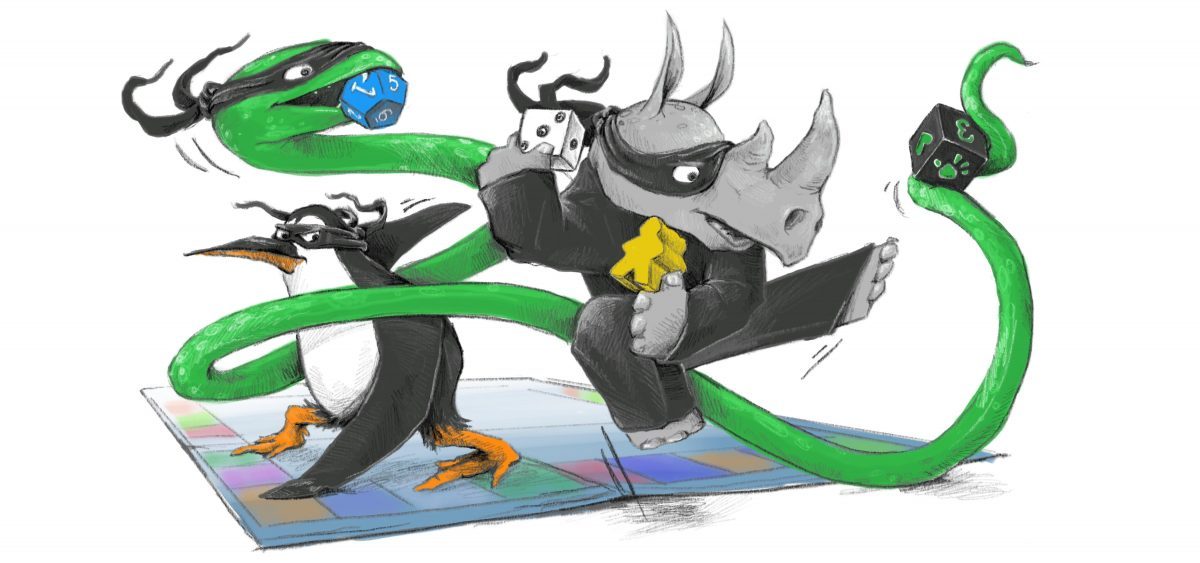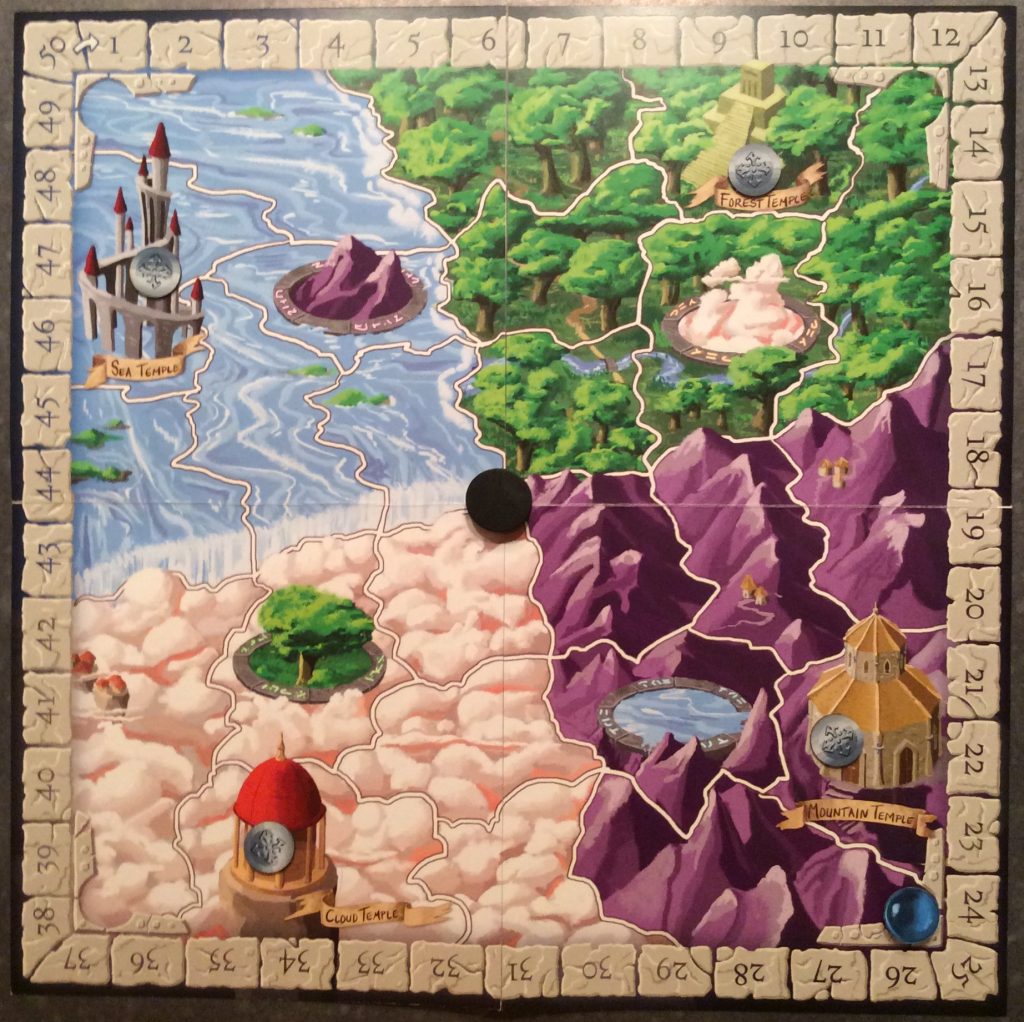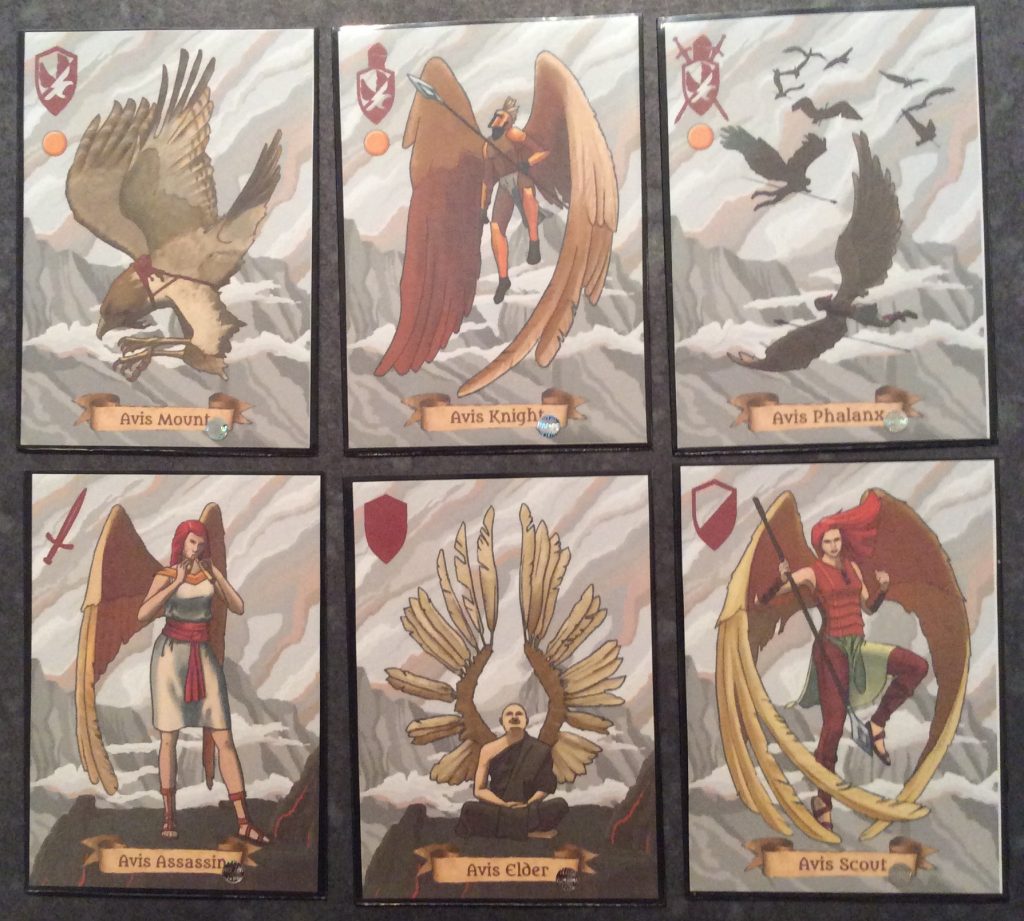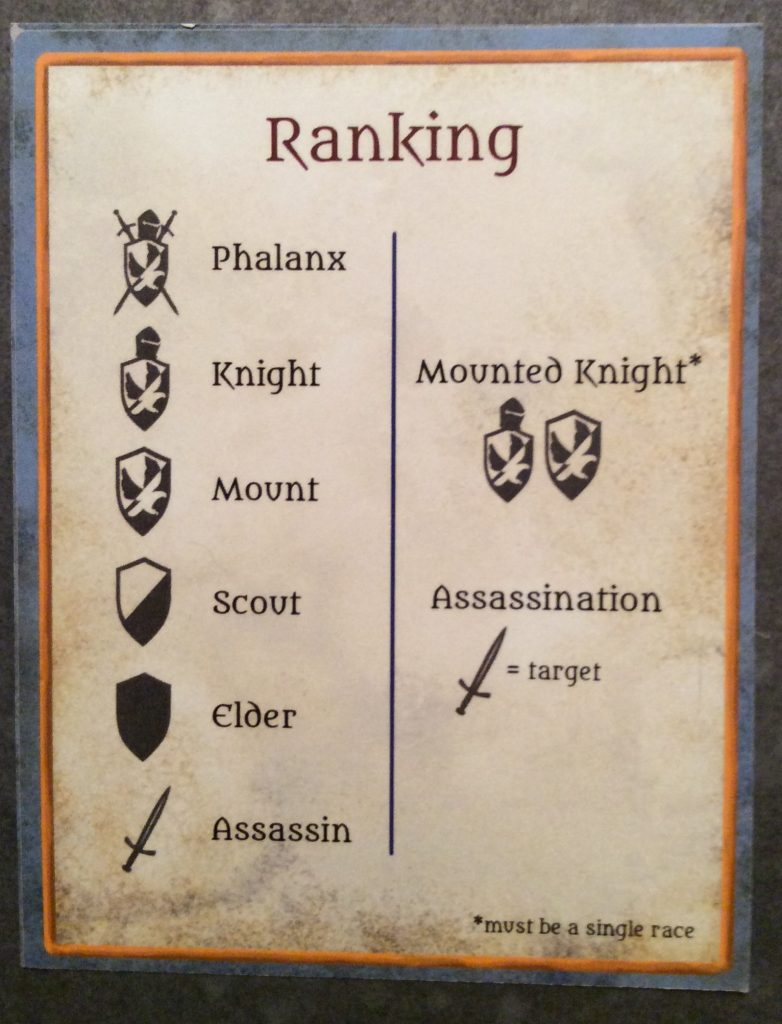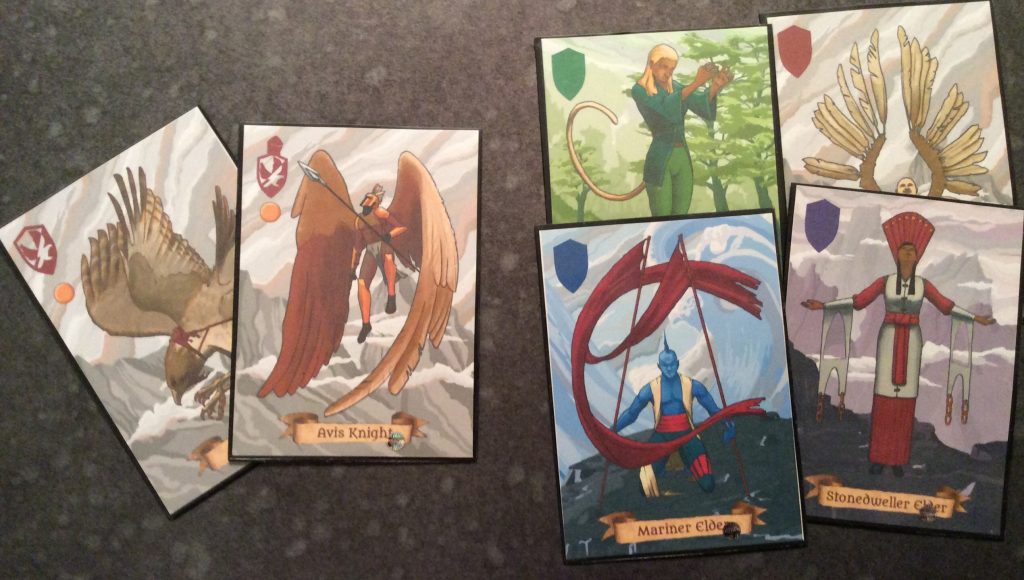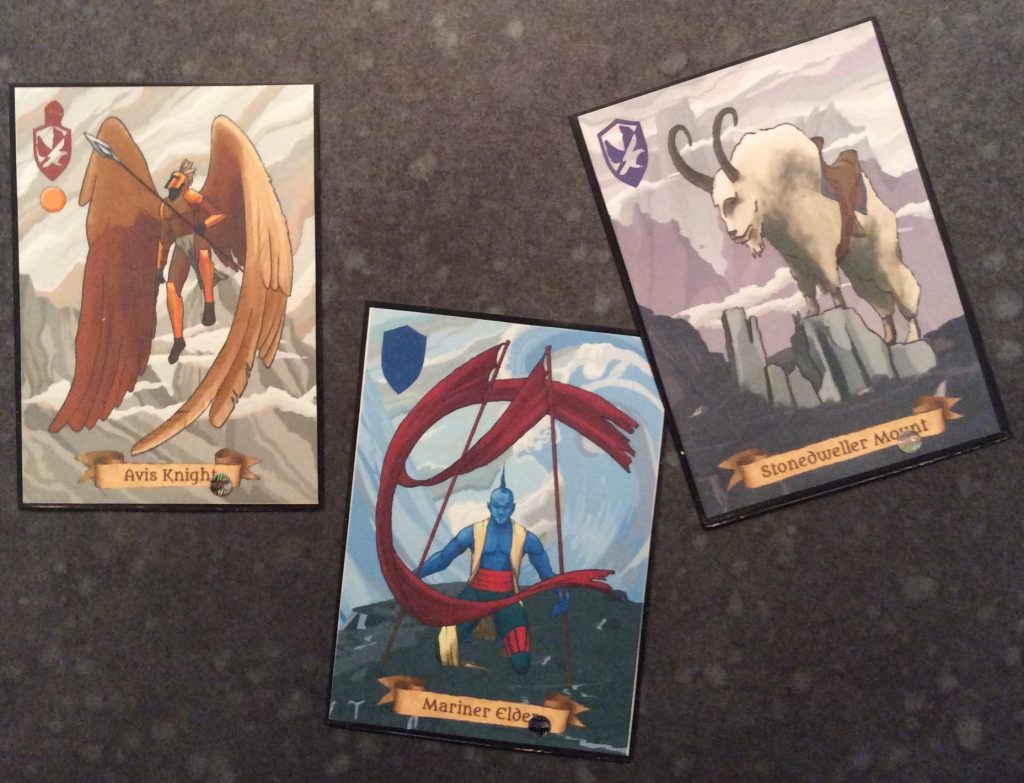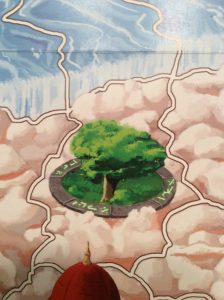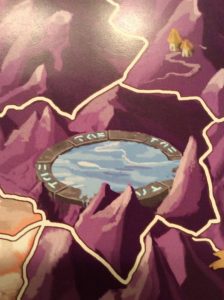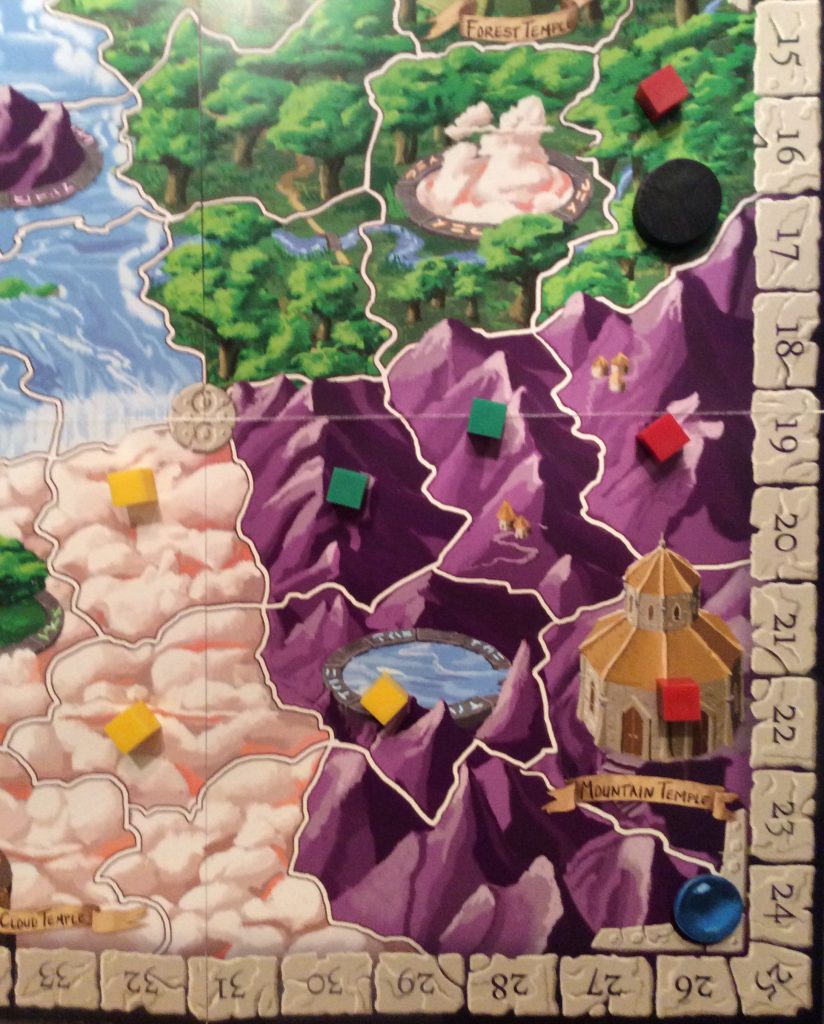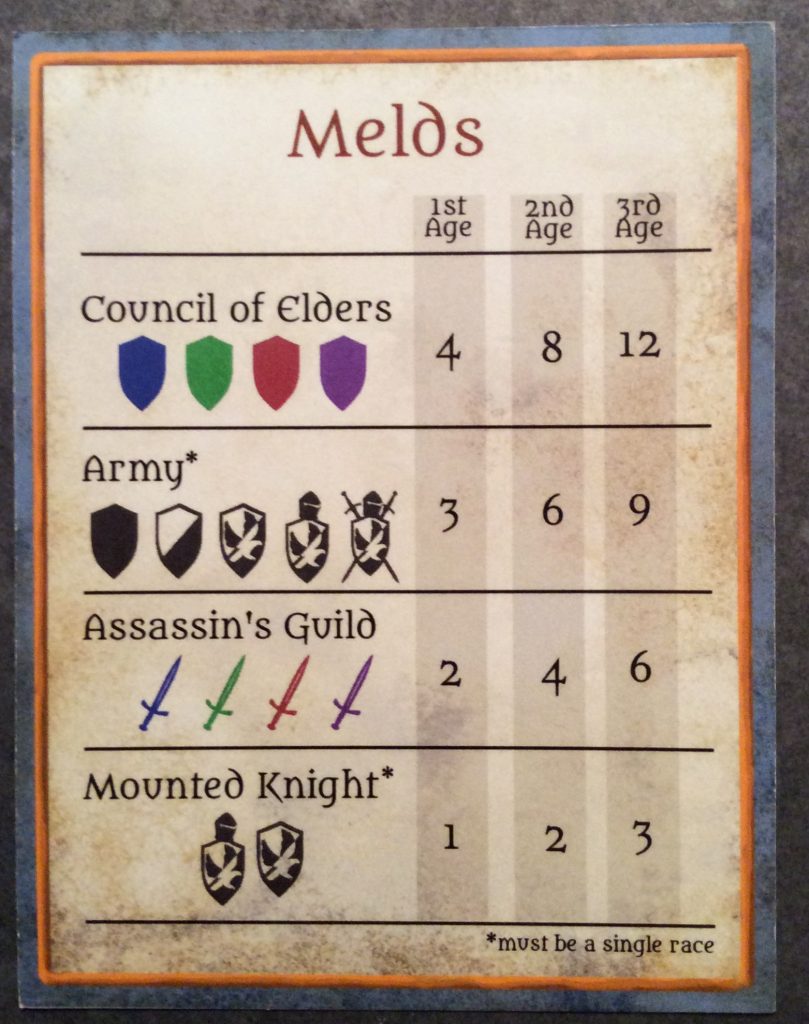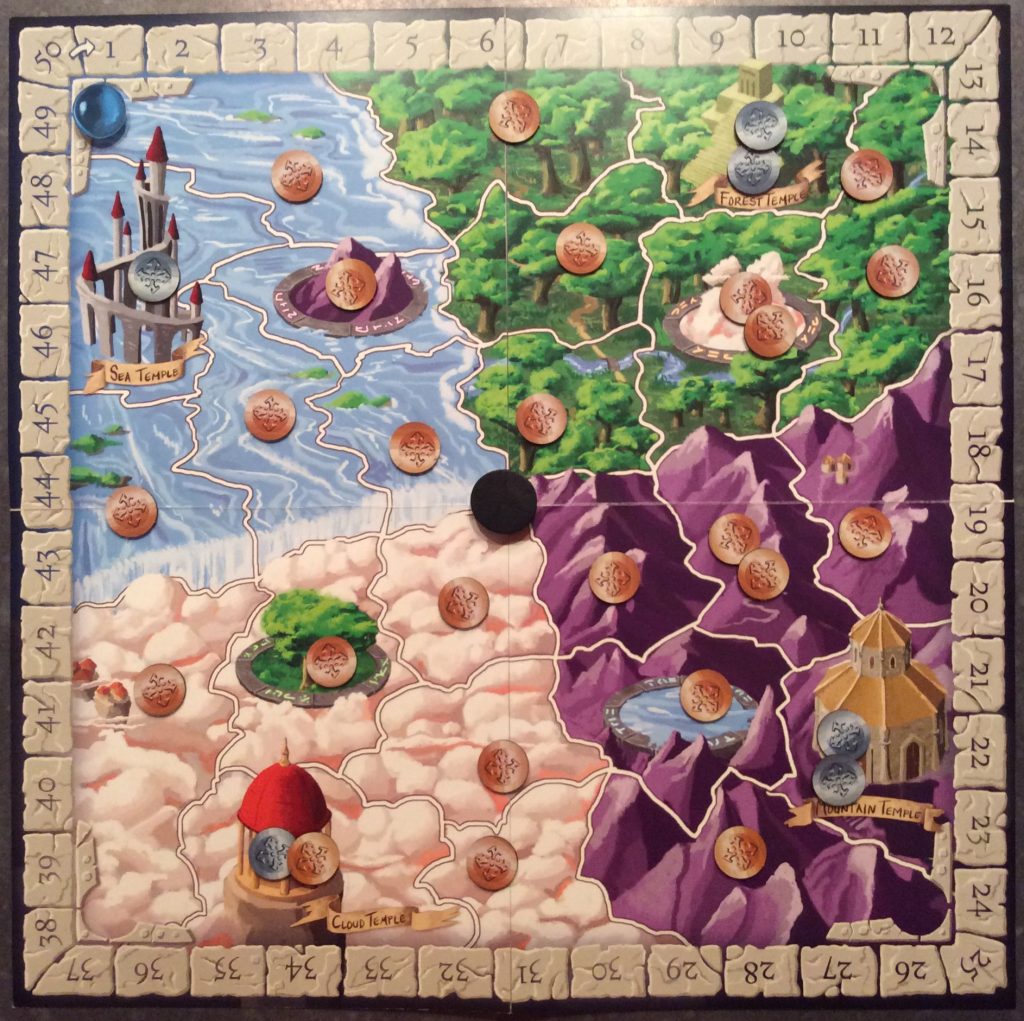So I noticed this game for the first time when it was on Kickstarter back in September. I didn’t back it. I was not alone. But now it’s back, and I won’t make the same mistake again.
You see, this game is incredible. It combines card drafting, set collection, area control, and trick taking. And it does it very well. The game is well-balanced and a whole lot of fun. Sometimes you play a game and immediately know you need to own it – this is one of those games.
Let’s take a look:
Radiant takes place in the world of Perim, where players use four races to vie for control over the course of 3 Ages. The board in Radiant is divided into four realms, each home to one of the four races: the Stonedwellers of the mountains, the Mariners of the sea, the Avis of the clouds, and the Treefolk of the forest.
During the game, these races will battle it out for control of different regions within the realms. All races have the same type of units available for battle, but the ability to use each race depends upon the location of the battle. The Avis units can be used in the cloud regions, the Mariners in the sea regions, and so forth.
But in addition, during each of the 3 Ages, one race is Radiant. This means that this race can be used in battle, no matter where the battle is taking place. Say the battle is taking place in the mountains, and the Treefolk are Radiant. In the battle, you can use Stonedwellers or Treefolk.
But we are getting ahead of ourselves, because the battle is the third part of every Age. Before you get to battle, you have to draft the cards you are going to use in the battles, and then you have a chance to show off your collected units.
Phase One: Recruit. So…let’s look at the cards. There are six types of units that are available to draft: Phalanxes, Knights, Mounts, Scouts, Elders, and Assassins.
Phalanxes are the strongest individual units, then Knights, and so on. Knights and Mounts can be combined and become the strongest unit, the Mounted Knight.
Assassins can be used to “kill” another player’s card; basically, it replaces your Assassin and becomes your unit for the battle. To use an Assassin, you must pick an opponent and declare which unit of theirs you wish to assassinate (the Assassin must be native to the current region and can only assassinate a member of the native race). If they have that card in their hand, you get it; if not, then your Assassin remains your card for this battle.
You start the game with a hand of either 8 or 9 cards (depending on the number of players) and then, one at a time, you will recruit a card from the drafting pool (9 cards that are replenished immediately every time one is recruited). But first, we need to decide which of the races is Radiant for the Age. This is decided by looking at the top card of the deck. Whichever race the card belongs to is the race that is Radiant for this Age (the Radiant race will then move clockwise next Age so that 3 different races will be Radiant during the game). Once you know the Radiant race, everyone takes turns recruiting one card until everyone has drafted 4 additional cards.
Phase Two: Meld. Now that everyone has all their cards, we are almost ready for the battle. But…before we go into battle, you get the chance to show off your army. This stage of the game is called the Meld. If you reveal to your opponents that you have certain sets of cards in your hand, you score points. Do you have an Elder from each of the races? Or an Assassin from each? Or maybe a Mounted Knight? Well, you have a choice to make. You can reveal the cards to your opponents and score points, but then your opponents know which cards you have and this can greatly influence the outcome of the Battle.
Phase Three: War. Okay, now that we have all of our cards, and we have completed the Meld phase, we can move on to the battles. The player that has the most Scouts begins the war by choosing a region to move the Battle Tracket into. The Battle Tracker starts in the middle of the map and can be moved into any of the four regions it touches. Once you’ve chosen which region the battle will take place in, you choose a card to play for the battle. You can choose to play a card that is native to the region the current battle is taking place in, or a card from the Radiant race. Either one can be played and neither race is considered higher when resolving the battle.
Whichever player plays the highest-ranked unit of one of the appropriate races wins. If two players play the same unit, the first player to play the unit wins.
Once you win the current battle, you claim the played cards and place one of your markers on the region. You now control that region. Since you won the battle, you control where the next battle will take place. Move the Battle Tracker again, selecting the next region that will host the battle. Some of the regions will also have copper or silver coins on them. During the first age, only the Temples will have coins, each having one silver coin present. While setting up the second and third age, you will add one silver coin to each temple and one copper coin to each other region. These can pile up if no one conquers a region during an age since the coins will carry over.
There are also 4 spaces on the board that are portals.
You can use these to move to the opposite side of the board. Also, in these particular regions, you can use the pictured race as well.
Scoring: At the end of each age, whoever has the majority in each realm is awarded 4 points.
If there is no majority, no points are awarded. Players also receive 1 point for every copper coin and 3 points for every silver coin they have collected this age. Also, at the end of the third age, players receive 1 point each for any card they have won that has a victory coin printed on it. Whoever has the most points wins.
Gameplay: Okay – that sounds like a lot, so how’s it play? Well, it is awesome. There are lots of decisions to make each turn and each of the different mechanics present in the game really make you think about your choices.
When drafting your cards at the beginning of each age, you have to be mindful of which race is Radiant and how many of each race are present in your starting hand of cards. If you have none of the Radiant race in your starting hand, you are going to need to recruit some, or risk having a bad War phase.
If you look at your starting hand and realize you are close to completing one of the higher scoring Melds, it may be worth recruiting a lower-ranking card to complete the Meld and score those points during the Meld phase.
During the Meld phase, you have to choose if you are going to reveal your cards to score a Meld or keep them secret in order to do better in the War phase.
In the War phase, you must play the right cards to win each battle or choose which card to play if you realize you have no chance of winning (which can actually be a hard but very important choice). Okay, you won that battle, which region do you move to now? Do you have the right Avis cards to win another Cloud region, or should you move to the Mountains since you have a Stonedweller Phalanx? Should you risk using your Assassin if you can’t remember which of your two opponents drafted the Mariner Knight?
Lots of good choices, and tons of fun.
Radiant is also very well-balanced. If you’ve ever played trick-taking card games before, you know that the hand you are dealt can make or break your chance at winning. Radiant compensates for the possibility of a bad starting hand by having 2 races that can be played in each region (both the native race and the Radiant race). You are also able to combine 2 cards to make the highest-ranking card combo, the Mounted Knight.
By doing this, you win a specific region, but may pay for it later because you will have one less card to play at the end of the age. The same goes for the Assassin card. It is not a high-ranked card (but can become one) and at the same time, removes an extra card from an opponent’s hand.
It is also nice that points for controlling regions are only awarded to someone who has a majority in that realm. That way if someone goes on a winning spree and controls four of the Cloud regions, it doesn’t mean that they will run away with the game, since all of that effort only results in 4 points. Also once they run out of Stonedwellers, they may not have the right Treefolk cards to continue their run. Someone else may win the next battle and then there may be an opportunity for you to jump in and take control.
If you don’t have a possibility of winning the next battle, you can move the Battle Token to a region that has already been claimed. This will force your opponent to spend cards to defend a region that they had already controlled.
Since you have to play a card native to the region, it is sometimes very important to know which card to throw away. Sometimes by the time it is your turn, the outcome of the battle has already been decided and you need to waste a card, especially in a 3-player game. Managing your hand correctly is very important.
It is also important to note that the outcome of the game is heavily weighted towards the third age. The Meld scoring in the third age is triple that of the first age, so revealing your cards during the Meld may actually be worth it.
Also there will be lots of coins on the board during the third age (during one 3-player game, we actually ran out of coins to place on the board, there were so many).
So winning regions becomes much more valuable. Weighting the third age this way allows for a player who did not do very well in the first or second age to catch up in the third and possibly still win. No one feels like they are out of the game. This keeps everyone involved.
Final Thoughts: Okay, so I’ve already gone on about how much I really enjoyed this game, but it really is that good. The gameplay is very well-balanced and well-paced. Everyone is always involved and there isn’t much of a lag between your opponents’ actions and yours. There is also a lot of strategy built in. There are always a bunch of interesting decisions to make and ones that you make early in the Age will affect the ones you are able to make later. Sometimes your plans work out, and sometimes you are completely screwed out of moves by your opponents by the end of an Age.
The artwork is really good, even though I had an older set of cards, so I’m assuming it will only get better. There was also an upgrade available in the original Kickstarter (which I’m hoping will be an option again) to upgrade all of the components.
A note about player count: the box says that it plays 2-4 players, but I really think you should stick to 2 or 3. The 4-player game involves team play, which was okay, but I liked it better without a teammate.
I don’t think I have to tell you that I will be backing this one the second it is relaunched (I’ve already apologized to my wife). Now I only have to addict all of my friends and manipulate enough people to make sure it gets funded this time around. That means you. Don’t miss out on this one.
Ninja Approved!!!
Tin Shoe Games sent us a copy of Radiant in exchange for a honest review, which is exactly what we have provided.
